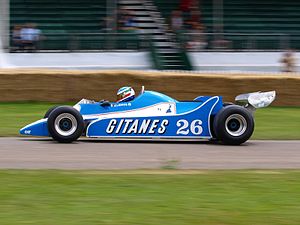Ligier JS11
 |
|||||||||
| Category | Formula One | ||||||||
|---|---|---|---|---|---|---|---|---|---|
| Constructor | Ligier | ||||||||
| Designer(s) |
Gérard Ducarouge Michel Beaujon Robert Choulet |
||||||||
| Predecessor | JS9 | ||||||||
| Successor | JS17 | ||||||||
| Technical specifications | |||||||||
| Chassis | Aluminium monocoque | ||||||||
| Axle track | Front: 1,738 mm (68.4 in) Rear: 1,600 mm (63 in) |
||||||||
| Wheelbase | 2,794 mm (110.0 in) | ||||||||
| Engine | Ford Cosworth DFV, 2,993 cc (182.6 cu in), 60° V8, NA, mid-engine, longitudinally mounted | ||||||||
| Transmission | Hewland FGA 400, 6-speed manual | ||||||||
| Weight | 580 kg (1,280 lb) | ||||||||
| Fuel | Shell | ||||||||
| Tyres | Goodyear | ||||||||
| Competition history | |||||||||
| Notable entrants | Ligier Gitanes | ||||||||
| Notable drivers |
|
||||||||
| Debut | 1979 Argentine Grand Prix | ||||||||
|
|||||||||
| Constructors' Championships | 0 | ||||||||
| Drivers' Championships | 0 | ||||||||
The Ligier JS11 was a ground effect Formula One car designed by Gérard Ducarouge. It was powered by the Ford Cosworth DFV married to a Ligier in-house built gearbox. It competed in the 1979 and 1980 World Championships and proved to be very competitive.
Driven by Jacques Laffite, the car won the first two races of the 1979 season and scored consistently. The Ligiers stayed in contention throughout the season, with Patrick Depailler winning a further race in Spain. The team eventually finished third behind Ferrari and Williams in the constructors' championship. Depailler was injured halfway through the season in a hang-gliding accident and was replaced by Jacky Ickx, but he struggled to keep pace with the car and his team mate and left at the end of the season, having scored only a handful of points.
For 1980, the JS11 was updated with improved aerodynamics and better ground effects. The team took on Didier Pironi in place of Depailler. Again the car was fast and competitive, but the Brabham BT49 and the Williams FW07 proved to be the cars to beat, with Alan Jones taking the world championship. Even so, the team still scored two wins, and would surely have taken more but for several suspension and tyre failures in the mid season. The car was producing so much downforce that the suspension and wheelhubs were coming under direct loading and therefore stress fractures developed. This was due to the immense pressure exerted on the suspension arms and the wheels by the ground effect, causing them to fail under hard braking. This effectively cost Ligier the chance to fight with Williams and Brabham for both titles.
The team finished second in the constructors' championship in 1980 ahead of Brabham, and the JS11 evolved into the JS17 for 1981. The JS11 was used as a primary test car for Michelin to experiment with their tyres.
...
Wikipedia
